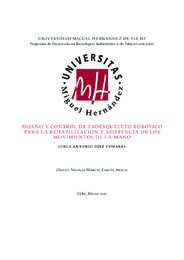Por favor, use este identificador para citar o enlazar este ítem:
https://hdl.handle.net/11000/27491Registro completo de metadatos
| Campo DC | Valor | Lengua/Idioma |
|---|---|---|
| dc.contributor.advisor | Garcia-Aracil, Nicolas | - |
| dc.contributor.author | Díez Pomares, Jorge Antonio | - |
| dc.contributor.other | Departamentos de la UMH::Ingeniería de Sistemas y Automática | es_ES |
| dc.date.accessioned | 2022-07-11T09:06:37Z | - |
| dc.date.available | 2022-07-11T09:06:37Z | - |
| dc.date.created | 2021-07-15 | - |
| dc.identifier.uri | https://hdl.handle.net/11000/27491 | - |
| dc.description.abstract | Hands are one of the main instruments used by humans for interacting with physical environment. Furthermore, hands play an important role in other aspects of daily living such as non-verbal communication or postural control assisted by external supports. Therefore, individuals that suffer some kind of hand impairment become dependent in many common situations, reducing their quality of life. Developments in the field of robotics result in potential solutions to overcome their dependency. In particular, wearable devices such as exoskeletons can help to lessen the impact of the impairment by becoming a new tool for providing more intense and effective rehabilitation therapies, or by their potential applications to assist people during their activities of daily living in a domestic environment. This Doctoral Thesis focuses on the development of a robotic exoskeleton that, due to its constructive features, can be applied to both rehabilitation and assitance environments. As an innovation, this exoskeleton has a new type of force sensor architecture, integrable in the device, favoring the lightness and portability of the equipment and offering a versatile force control interface in a multitude of environments. Along with the force interface, other types of interfaces based on biological and kinematic parameters are studied, in order to provide the system with the necessary versatility to adapt to different user profiles. In addition, two practical applications of the device are presented in complex rehabilitation settings and everyday situations not previously studied. The results of this work are compiled in four publications in journals indexed in the Journal Citation Reports (JCR). The publication Multimodal robotic system for upper-limb rehabilitation in physical environment studies the integration of the hand exoskeleton in a system of robots and sensors that allow the implementation of manipulative therapies in real environments, using a human-machine interface based on electromyographic signals. As an alternative to electromyography for advanced stages of rehabilitation, new interfaces based on motion capture and force feedback are proposed, results are published in the paper Hand exoskeleton for rehabilitation therapies with integrated optical force sensor. A detailed description of the force sensor integrated in the exoskeleton can be found in the publication Customizable optical force sensor for fast prototyping and cost-effective applications. Finally, the publication Exploring new potential applications for Hand Exoskeletons: Power grip to assist human standing studies the applicability of hand exoskeletons to improve postural control. | es_ES |
| dc.format | application/pdf | es_ES |
| dc.format.extent | 225 | es_ES |
| dc.language.iso | spa | es_ES |
| dc.publisher | Universidad Miguel Hernández de Elche | es_ES |
| dc.rights | info:eu-repo/semantics/openAccess | es_ES |
| dc.rights.uri | http://creativecommons.org/licenses/by-nc-nd/4.0/ | * |
| dc.subject | Robótica | es_ES |
| dc.subject | Biomecánica | es_ES |
| dc.subject | Ingeniería de control | es_ES |
| dc.subject | Ingeniería sanitaria | es_ES |
| dc.subject.other | CDU::6 - Ciencias aplicadas::62 - Ingeniería. Tecnología | es_ES |
| dc.title | Diseño y control de exoesqueleto robótico para la rehabilitación y asistencia de los movimientos de la mano | es_ES |
| dc.type | info:eu-repo/semantics/doctoralThesis | es_ES |

Ver/Abrir:
Diez Pomares, Jorge Antonio_compressed.pdf
4,9 MB
Adobe PDF
Compartir:
 La licencia se describe como: Atribución-NonComercial-NoDerivada 4.0 Internacional.
La licencia se describe como: Atribución-NonComercial-NoDerivada 4.0 Internacional.
.png)